-> My Collection; The whole book can be seen here as an Image Only Album, or direct to the page of this text here.
(page 12-22)
Most mining camps of the world have had their ups and downs, their periods of prosperity and depression. It remains for Cripple Creek to alone claim the distinction that there has been no period of depression in its history, and not a backward step since it was first discovered in the way of production. True it has had labor troubles of more or less magnitude and the mercantile businesses of the district have suffered in consequence. It might also be said that there have been periods of wild cat flotations, wherein the investor has been fleeced of his money, but even this is a thing of the dim distant past.
At the present time there are no labor troubles of any kind in the Cripple Creek district, and what is more there will be none in the future. Between 3,000 and 4,000 men are at work digging out the gold in the eternal hills, and they are receiving the best wages and working shorter hours than any other class of men on earth. The Gold Coin mines are reducing the ore at their own plant, the Economic mill, the great Portland has its own reduction works at Colorado Springs, the Golden Cycle has just completed arrangements to build it own reduction plant at Colorado City, and the United States Reduction and Refining Co. has recently enlarged its plant at Colorado City, so that, with its other plants at Florence, it can handle immense quantities of ore from the district. The smelters have also put in additional and improved machinery, capable of handling thousands of tons of ore every month more than formerly.
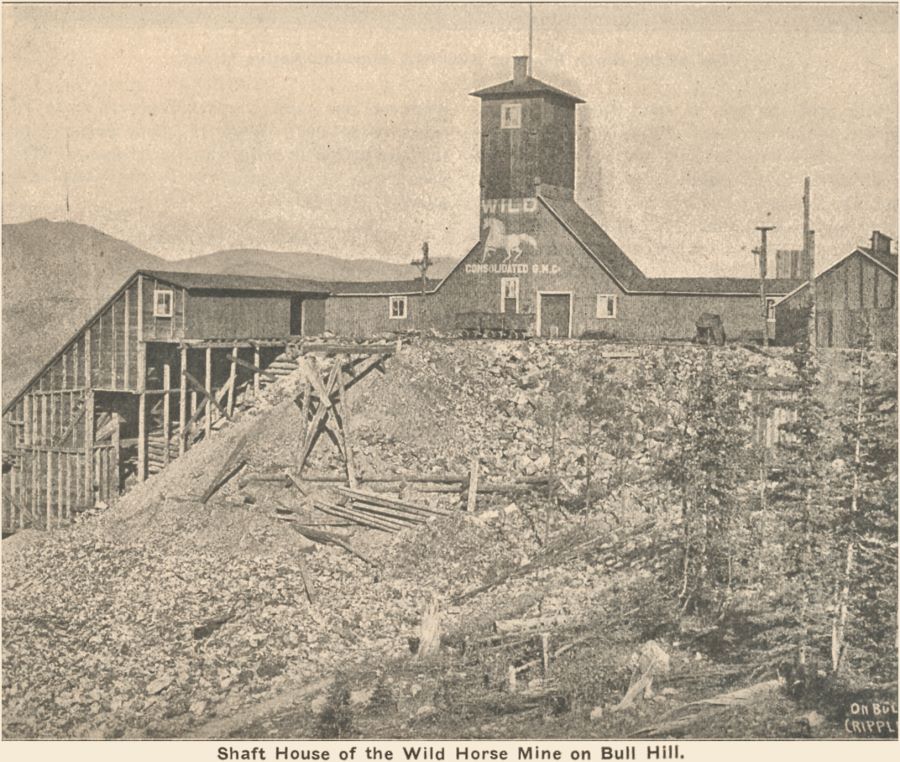 Wild Horse Mine.
Wild Horse Mine.
The mines in the district have been enlarging their ore houses, sinking new shafts, putting in larger compressors, new plants of machinery and increasing their capacity so as to be able to handle the increased output. Prosperity is everywhere, and everybody will share in it. That the production for the year 1904 will be larger than any previous year in the history of the Cripple Creek district, goes without saying. The total production this year will easily exceed $30,000,000, which will astound those who have believed that the district is yet in its infancy, and the probabilities are that each succeeding year, for many years to come, will produce more gold than the year before it. Within the past six weeks, nearly thirty new strikes have been made on properties throughout the district. Many of these have been phenomenal, and all of them will add greatly to the output of the camp. One of these strikes, that on the W. P. H., is the largest that has ever been made in the history of the world, even exceeding that of the Isabella, which startled the world in 1900. A brief resume of these strikes will be found in this article.
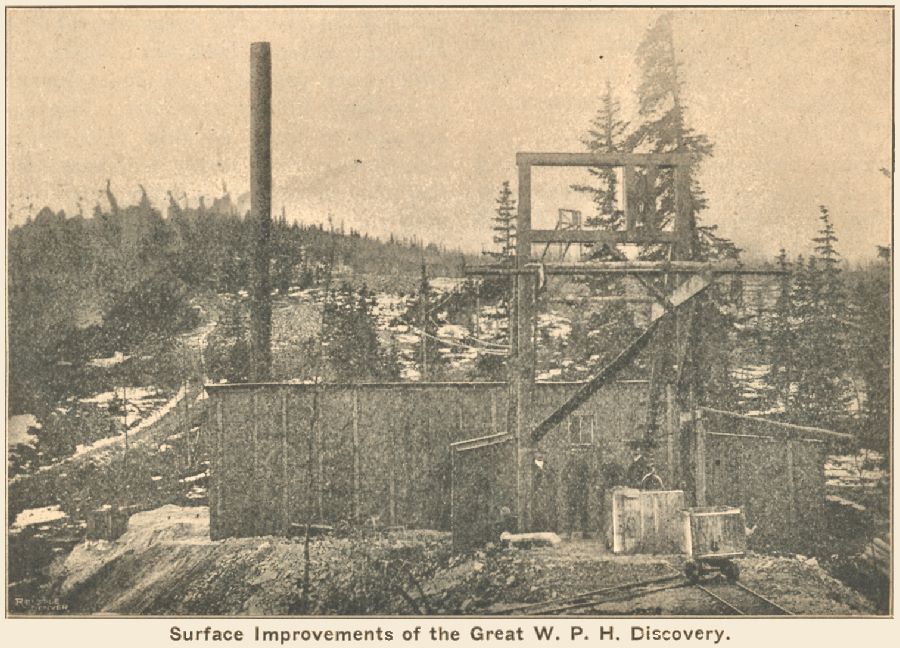 W.P.H. Exterior View.
W.P.H. Exterior View.
The W. P. H. claim is situated on Ironclad hill, only a short walk from Midway, a station on the High Line electric and the F. & C. C. railways. It was leased by Harrison & Seaber some months ago, and these men have been working the claim themselves. They have interested with them several business men, one of them being Judge Samuel Crump. The claim adjoins that of the Jerry Johnson, which has taken out a large quantity of good ore. The lessees sank a shaft 245 feet deep and then drifted 100 feet to the east. It was at this point that the marvelously rich ore that has startled the world was found. The ore body is only 35 feet to the south of the first ore that was found on the property.
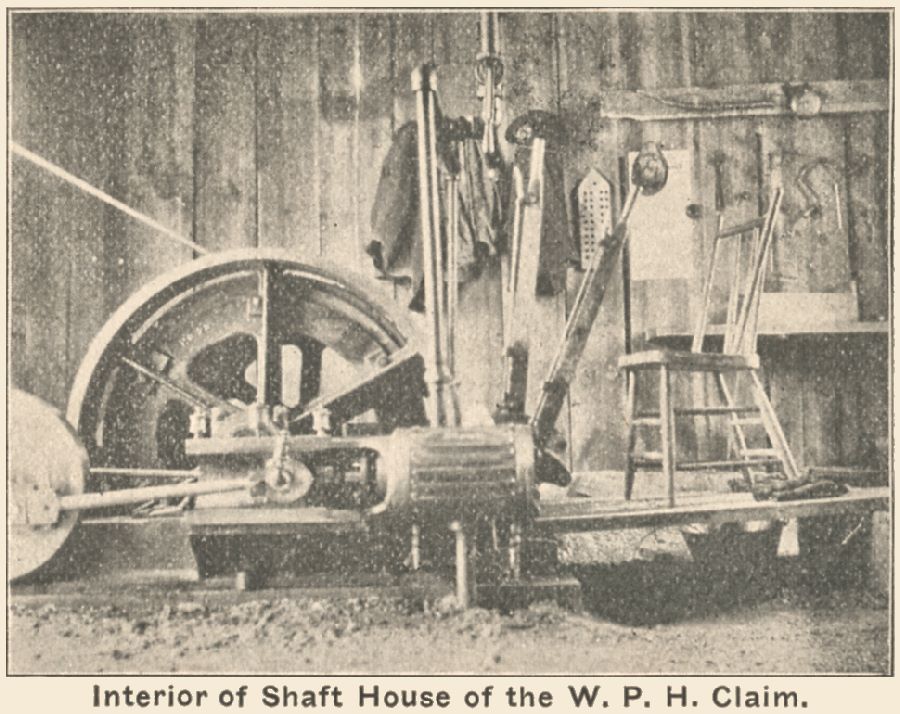 W.P.H. Interior View.
W.P.H. Interior View.The Hoist in the House
The vein is four feet wide and carries three grades of pay rock. A streak 18 to 20 inches in width runs better than $46,000 to the ton. Four inches of this rich streak is from 75 to 90 per cent. pure gold. It is just like mining so many $20 gold pieces from the ground. The second grade runs $3,000 to the ton, and this streak is 18 inches wide. The remainder of the vein pays better than $500 to the ton. The lessees call this ore their "low grade." There is apparently an unlimited amount of pay ore besides the very rich vein, which will run up to $100 to the ton.
Ore houses have been built, and arrangements have been made to handle a large output. The strike consists of sylvanite, free gold, cube gold and rusty gold. The rich ore is sacked, and the three men working on the lease have been shipping $65,000 worth of rock every three days.
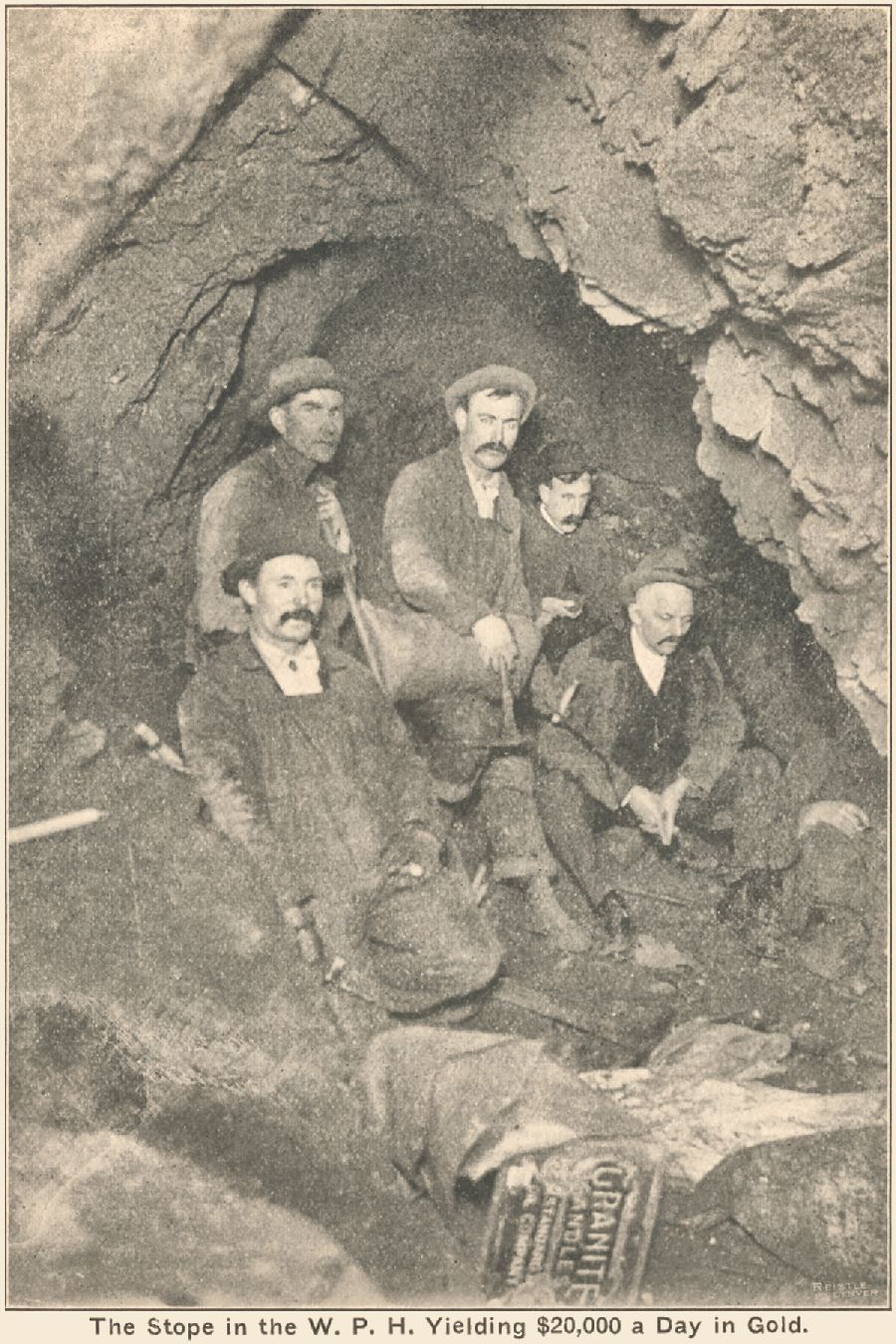 W.P.H. Stope View.
W.P.H. Stope View.
The strike made on the W. P. H. property is still holding its own. The breast south has increased in value from $2,000 across the 22-inch vein to almost twice that value. The gold which is in plain sight continues and the more taken out the better it looks. Attorney Crump, one of the lessees, stated that the new strike is still improving with investigation and that they had started with the object of preparing a $100,000 shipment to be sent out the latter part of this week. However, one-half of this quantity of ore is already sacked and piled up in the drifts being watched by two armed guardsmen.
People who have not seen this wonderful shoot, the like of which has never before been seen, can have no conception of its wonderful richness. Old-timers of the district are stupefied when they gaze upon the strike made in the W. P. H. property.
At the present time only three men are working on the rich ore and while these men are lessees, heavily armed guards watch every ounce of the rock taken from the ground.
If the shoot holds out as it has every appearance of doing there ought to be mined from this property in the neighborhood of $600,000 during the present month, and it would not be a surprise if these figures might possibly be largely increased.
Brooms are now being used in the short drift and all of the rock that happens to get into crevices is also being saved by this means. The lessees say that if the shoot extends down any distance they will make a broad gauge carload shipment from their 20 inches of high grade that will make the Isabella look like a low grade mine compared with theirs. According to the estimates of the lessees, the same shoot will dip into the Forest Queen, situated north of them, and according to its depth it will be cut at about a depth of 600 feet. Major Walsh of Chicago is working this property under a five years' lease. It is owned, however, by Denver people.
The old mines of the district have been making as good a showing as the new properties. The Portland, recognized to be the greatest mine in the district, has made 33 new strikes within the last 60 days. Ten of these finds have been made in the present year. The greatest of the new strikes was made only 300 feet north of the main shaft of the property. Another almost as large was made 500 feet in the same direction. In the first instance a vein three feet in width was discovered that runs better than six ounces in gold to the ton. All of the new strikes will run better than $40 to the ton. The Portland is located on Battle Mountain, one of the great producers of the camp. The Portland has a most wonderful history, having paid $12,000,000 since 1894. The property employs more than 500 men.
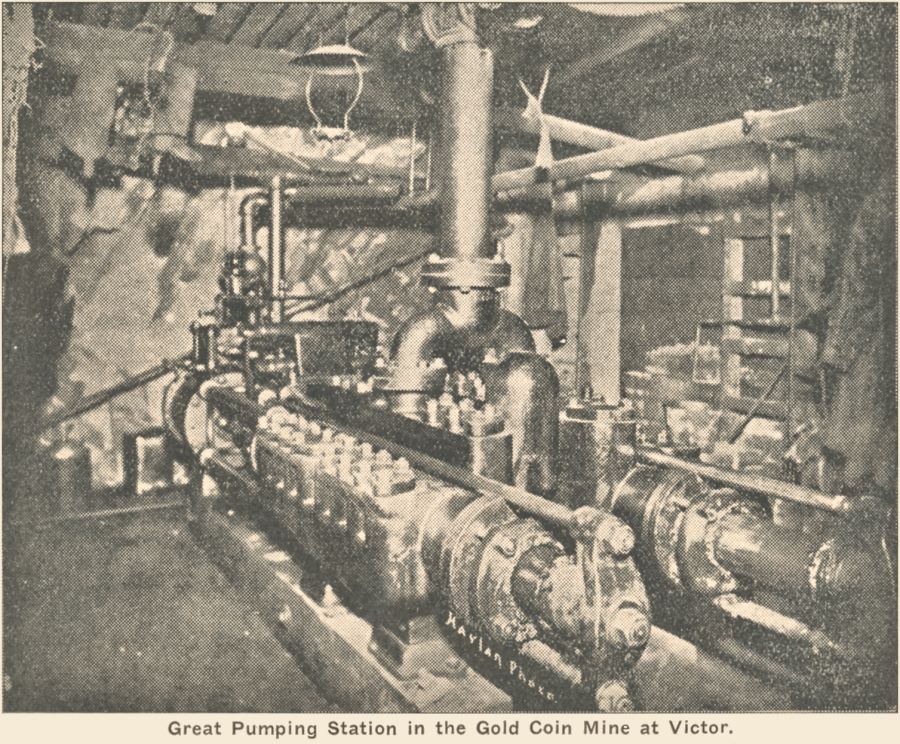 Gold Coin Pumps.
Gold Coin Pumps.Photo: A.J. Harlan
The Gold Coin mine, located in the very heart of the city of Victor, has not only maintained a steady and large production since it was discovered, but every few months it opens new ore bodies of wonderful richness. It has just made a big strike in the 900-foot level, 1,000 feet north of the main shaft. The new vein is very wide and runs higher in values than anything ever taken out of the mine. This mine has the finest shaft house in the district and has already paid more than $1,000,000 in dividends to its stockholders.
The Granite mine on Battle Mountain has long been maintaining a steady production of 80 tons of ore a day. It has just made a new strike of a vein 10 feet wide on the 1,000-foot level, and 700 feet south of the main shaft. The ore runs better than $50 clear across the vein. The mine has produced between $2,000,000 and $3,000,000 in gold to date.
Jack Camden, leasing on the Bonanza King, has just found two and a half feet of ore at a depth of ten feet that is alive with free gold. The assays run as high as $5,180 to the ton. The new strike will be pushed with vigor, and a big producing mine will no doubt be opened up in the next few weeks.
Lessee Schoernherst of the Hardwood claim on the Damon on Ironclad hill has opened up 12 feet of better than $50 ore. He caught the shoot at grass roots and obtained pay values when through the wash, which is nine feet deep. He caught the main shoot in drifting south at 35 feet depth.
Colonel Puckett, leasing on the Pride of Cripple Creek, adjoining the now famous W. P. H., caught a vein one and a half feet wide at a depth of 185 feet and is shipping ore running from six to ten ounces in gold to the ton. He did a large amount of trenching before he caught the ore body. He expects to develop a big mine from his find, as the ore in Ironclad is anything but pockety.
Lee Glockner & Co., leasing on the Empire State, have found an ore shoot three feet in width that runs from 40 to 200 ounces of gold to the ton. This strike is a most important one, and will make the lessees as well as the owners of the property wealthy.
Bannington, Ford & Brady have opened up a big ore shoot on the Tornado on Raven hill and are shipping a large quantity of ore running three ounces to the ton. The shoot is well defined and will give immense returns.
James Wright, who has a lease on the Thompson on Raven hill, has secured an extension on his lease and expects to do wonders with his property in the present year. During the first two weeks in January of the present year he shipped 48 cars of ore averaging $24 to the ton. He expects to ship about 100 cars a month averaging better than $25 to the ton. His shoot is gradually getting larger and of better values.
The C. K. & N. and Old Gold on Beacon hill are both shipping about 2,500 tons a month from recent finds and the ore runs better than $40 to the ton. The ore shoot in each instance was caught at 350 feet deep.
A strike of large proportions has just been made on the El Paso property on Beacon hill, for it is almost impossible to obtain the exact figures. It is known, however, that one shipment of less than a carload of ore gave returns of $11,000. Work is being pushed and the production is being rapidly increased. The production of the property to date has been about $1,000,000.
George L. Keener, formerly superintendent of the Mary McKinney mine, is now leasing on the Sunset Eclipse on the North slope of Squaw mountain. He is sinking two shafts and both of them are in ore. The shafts are only 50 and 60 feet deep. The ore is running from two to five ounces to the ton, and the prospects for an unlimited quantity are the best. The indications are that the lease will develop into a big mine.
Russell & Sharp, leasing on the Colorado Boss on Gold hill, have struck an ore body two and a half feet in width and are shipping ore running on the minimum $40 to the ton. They are pushing development work and expect to soon have a big mine.
One of the most wonderful of all the strikes and stories of production is that of the Le Claire claim at Anaconda, owned by H. M. Gilbert. The claim consists of less than one acre, and the price paid for this little patch of ground was $12,500. During the month of December, 1903, the little claim paid $4,000 in royalties figured at only 15 per cent. on the total value. The shaft is only 327 feet deep. The ore shoot consists of flourine and sylvanite and is very rich. The values never run less than $120 to the ton, and from this figure up to $2,000 to the ton. Mr. Gilbert is again sinking and taking out rich values as he goes. Expensive and improved machinery is being installed, sufficient to take care of the large and increasing output of the mine.
The Bayard M. & L. Co., leasing on the Trilby claim of the Moose company on Bull hill, have just made a big strike and are shipping 40 tons of ore a day running from two to five ounces to the ton in gold. This property adjoins the Gold Sovereign. Two new ore bodies have been opened in the Trilby claim. 300 and 500 feet in depth, respectively. Each ore shoot is four feet wide. These finds promise to develop into something stupendous.
There was a report current a year or two ago that Stratton's Independence mine on Battle mountain had played out, yet it has been employing more than 500 men since it was opened up and has maintained an average production every year of its existence. Rich strikes in this property are of such frequent occurrence that they are scarcely noted in the newspapers. The mine is now sacking ore in the upper levels that is fabulously rich. It is shipping an average of 1,500 tons of ore every month and pays regular dividends. It has produced to date about $28,000,000 in gold, and is maintaining the figures on annual production. It is hardly probable that anyone acquainted with the figures would think the mine played out.
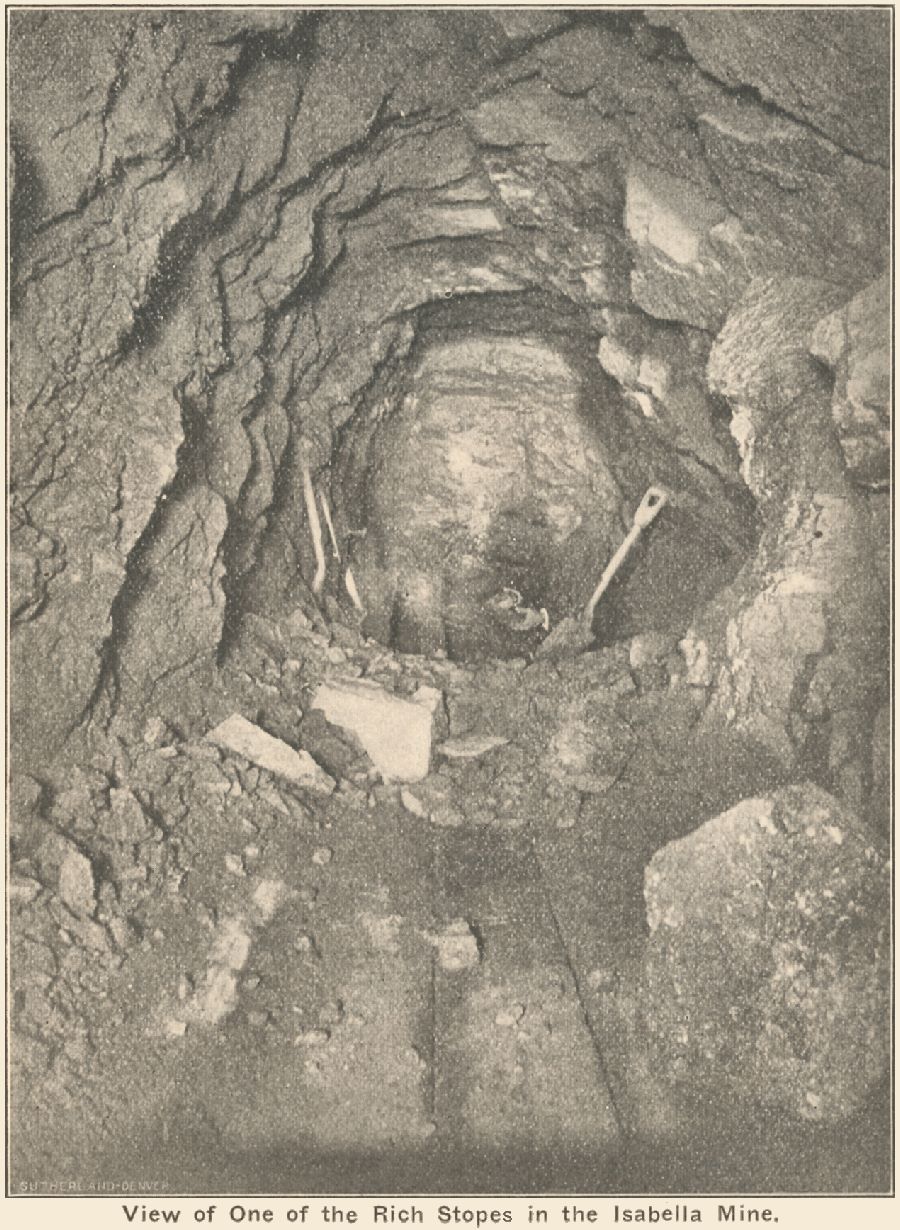 Isabella Stope View.
Isabella Stope View.
James Murphy and associates are again working on the Isabella on Bull hill, and have prospects for a large production in a short time. There are more than 12 miles of underground workings in the Isabella, and it has been and will be a great producer. Before the discovery of the W. P. H. mine, the Isabella held the banner record for a single shipment of ore. The Isabella in 1900 shipped 27 tons of ore that returned a value of $216,000. The mine has paid to date $5,000,000.
The Cripple Creek Temple M. & L. Co., leasing on the Gold Sovereign on Gold hill started work in what was supposed to be a worked-out drift 237 feet south of the main shaft at the 600-foot level. After working 15 feet, the company encountered an ore shoot three feet wide, the ore running from $100 to $120 to the ton. The company was about to throw up the lease when the big find was made. The shoot found is of great importance as it is parallel with the known shoots, and therefore an entirely new discovery. A small stringer was followed, which finally led to the big ore shoot. This property has produced to date about a third of a million dollars.
Altman & Smith, leasing on the Doctor-Jack Pot mine on Raven hill, have found an ore shoot running from five to seven ounces of gold to the ton. They are shipping regularly and expect to increase their shipments at once. These men are working through the old Doctor shaft. This property is one of the bonanzas of the district and has been a remarkable producer.
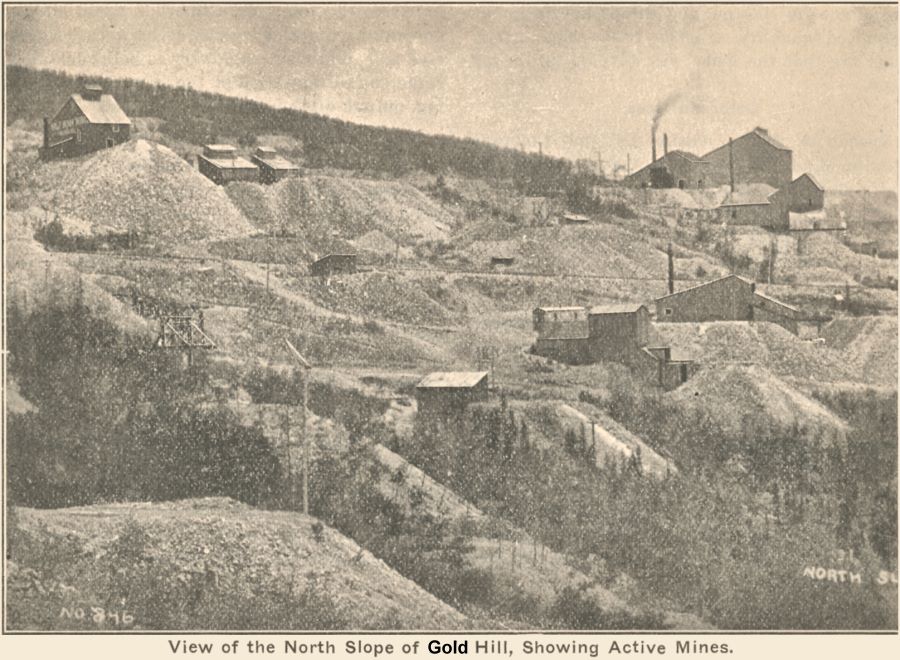 North Slope Gold Hill.
North Slope Gold Hill.Half Moon Mine is
seen at upper left.
Lessees Ryan & Jones on the Half Moon of the Matoa company on Gold hill, in running a drift 100 feet from the main shaft at a depth of 500 feet, encountered four feet of ore running from two to five ounces to the ton. They are now making regular shipments of 10 cars of ore a month and will increase this amount. This company is also sinking in the main shaft and expect to open a large ore body before many weeks. It is known to a certainty that the old rich shoot will be re-encountered by sinking. The mine has produced $1,000,000 up to date.
Senator James Owen and Tom Head, leasing on the Prince Albert on Beacon hill, have struck it rich in a tunnel driven 75 feet on a well-defined vein four feet; wide. Rich pockets of ore are found throughout the vein, which will make the mine pay handsomely. Some of the rock taken out is literally plastered with sylvanite.
The Findley mine at Anaconda is putting in a large new plant of machinery, and has rebuilt and enlarged its ore house. The production, which has been about 40 tons a day, will be doubled as soon as the new plant is in operation. This mine has the deepest shaft in the district, and its prospects for an immense producer are the best.
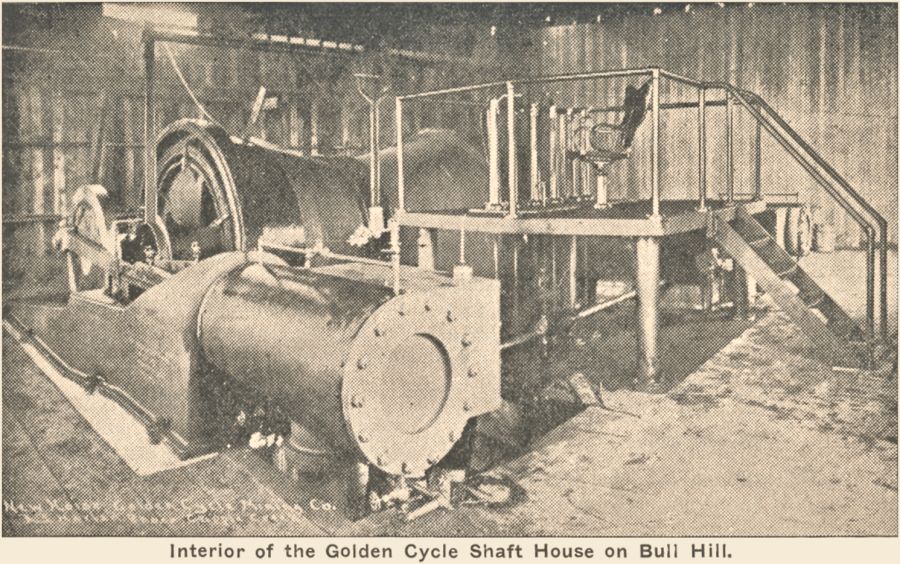 Golden Cycle Hoist.
Golden Cycle Hoist.Photo: A.J. Harlan
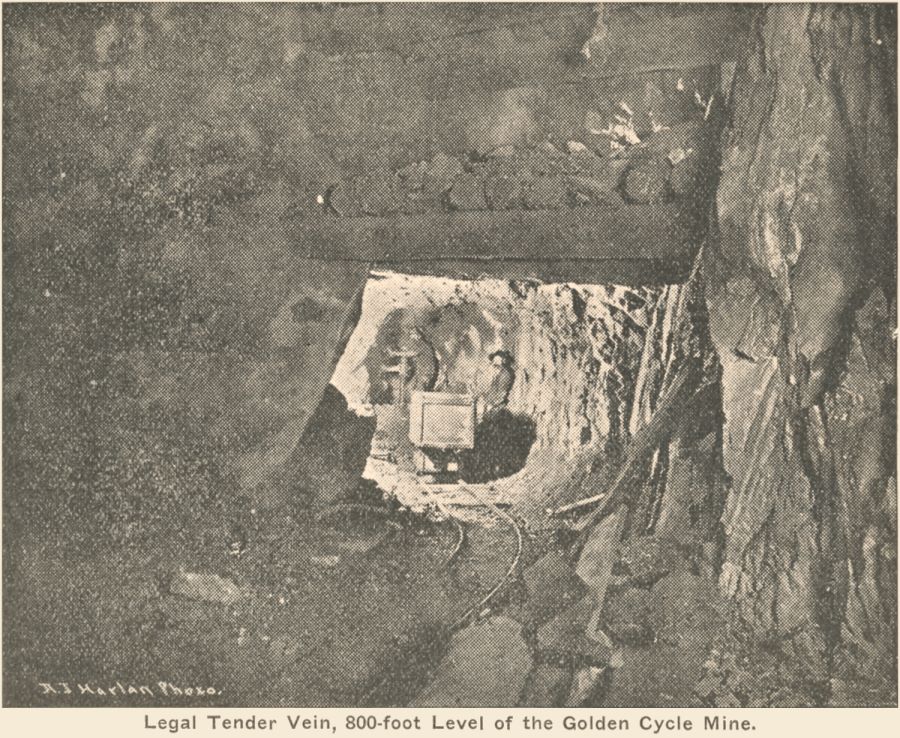 800 feet Underground,
800 feet Underground,Legal Tender Vein,
Golden Cycle Mine.
Photo: A.J. Harlan
The Golden Cycle on Bull hill is rapidly forging to the front as one of the large producers of the camp. This mine has made preparations to build its own reduction plant in Colorado Springs. It is now shipping 50 tons of ore a day and will handle and perhaps treble this amount upon the completion of the new reduction plant. The mine is at the present time employing 80 men. The production of the mine up to the present time has been about $3,000,000.
With the number of strikes reported recently comes one on the Ramona claim located near Windy Point on the southwest slope of Bull hill, and whose property adjoins the famous War Eagle. The lessees operating the Ramona are operating though the War Eagle shaft and have opened up five feet of ore which is running $40 to the ton, taken clear across the breast of the vein. The new find was made several days ago, but the lessees, Anderson, Johnson, Micshie and Henby, decided to await the demonstration of permanency of the shoot before making the news public and from the development in the past few days they felt justified in giving the news to the public.
Five feet of ore averaging $40 to the ton is a splendid strike when the size of the body is taken into consideration, and the lessees are to-day jubilant over their strike. From all appearances it has every indication of being the extension of the old War Eagle ore shoot, only much better than anything ever found in the War Eagle property.
The territory adjacent to Windy Point has long been a puzzle to mining men. Tons of good ore have been shipped from surface workings near this point but the main ore shoot has never been located, but the find made by the lessees on the Ramona may prove the source of the ore around this territory and the development will be watched with considerable interest.
According to the latest information assays taken across a five-foot vein of ore returned values of $200 a ton, and a shipment of 40 tons of $100 ore has been prepared.
Below the 500-foot point the property is being developed by Lessees Campbell and associates, who are working through the New York tunnel. Several Colorado Springs people are interested in the development of this lease.
The Ramona property is owned by Verner Z. Reed, who is now in Paris; C. C. Hamlin, Sylvester Johnson, W. B. Jenkins and Mrs. F. C. Walker, all of Colorado Springs.
Another new strike was brought to light last week, being on the Fulton-Marguerite on Gold hill, some 250 yards from the mouth of the Anaconda tunnel, or in close proximity to the recent strike made by Gilbert and associates on the Peggy claim. Whether the find is an entirely new ore shoot or the extension of the famous Davenport shoot of the Anaconda has not been determined.
The ore body, measuring 16 inches in width, was opened at a depth of 70 feet from surface and the lowest assays made ran better than $40 to the ton. The strike adjoins the old Davenport working of the Anaconda, where several years ago W. J. Davenport took out in the neighborhood of $60,000 worth of ore between the 60-foot point and surface; but the ore shoot was lost at the place and while a large amount of development work was done by the various lessees since then no one has been able to locate the source of the ore or to ascertain in what direction it went.
"There is enough ore between the bonanza shoot of the El Paso and the C. K. & N. line to pay for all the outstanding stock at current prices," is the declaration of an operator who has investigated the conditions.
A good strike has been made in the Abe Lincoln property, a portion of the Stratton estate which is operated by the Tunnel Mining & Leasing company, a close corporation, officered by well known Denver men. It is largely through the mining experience of Manager Walter Swanson that the new strike has been opened. The Abe Lincoln was one of the first properties to resume operations with non-union help and since that time more work has been accomplished than in any equal period before in the history of the mine. The shaft has been sunk from the 500 to the 600-foot point, a large station cut and an enormous amount of work accomplished at the 600-foot point, and it is in this level that the new strike has been made.
Driving 100 feet in an easterly direction they have encountered an ore shoot that measures 64 feet one way and 20 the other and the miners have not reached the walls on either side, giving it the appearance of an enormous cave. Men are working in two sides of the cave and will continue doing so until the extent of the body of ore is learned. At the same time they are shipping every pound of the rock which is taken from the large ore body, which is proving to be of good smelting grade. The formation of the new strike is a hard granite, which is literally sprinkled with sylvanite, the rich mineral being found in every crevice.
At another point a little southeast of the shaft they are driving a crosscut for the Arcada vein, having to go some 120 feet before it is encountered. This work will be accomplished within 10 days.
The Arcada vein is known as one of the richest in the district and when the leasing company quit work on the 500-foot level the vein measured between eight and ten feet in width, so it is expected to open much wider and probably richer at the 600-point. In all there has been over 300 feet of drifting accomplished on this lower level and nearly every foot of it in ore.
The company sent out a consignment of three carloads and another of two carloads which will return values of between $30 and $40 a ton. Besides working the 600-foot level operations are being pursued in the 365 and 500-foot points where regular shipments are being taken out.
James W. Levan and associates, leasing on the north end of the Pharmacist on Bull hill, have just struck it rich at a depth of 140 feet. They are now preparing a shipment from the ore shoot encountered at the depth stated. The shoot is three feet wide and runs better than $120 to the ton. The Pharmacist was the first mine in the Cripple Creek district to pay a dividend, and is equipped with an extensive and modern plant of machinery. The production of the mine to date has been more than $1,000,000. The friends of Mr. Levan all over the state are congratulating him on his exceeding good fortune.
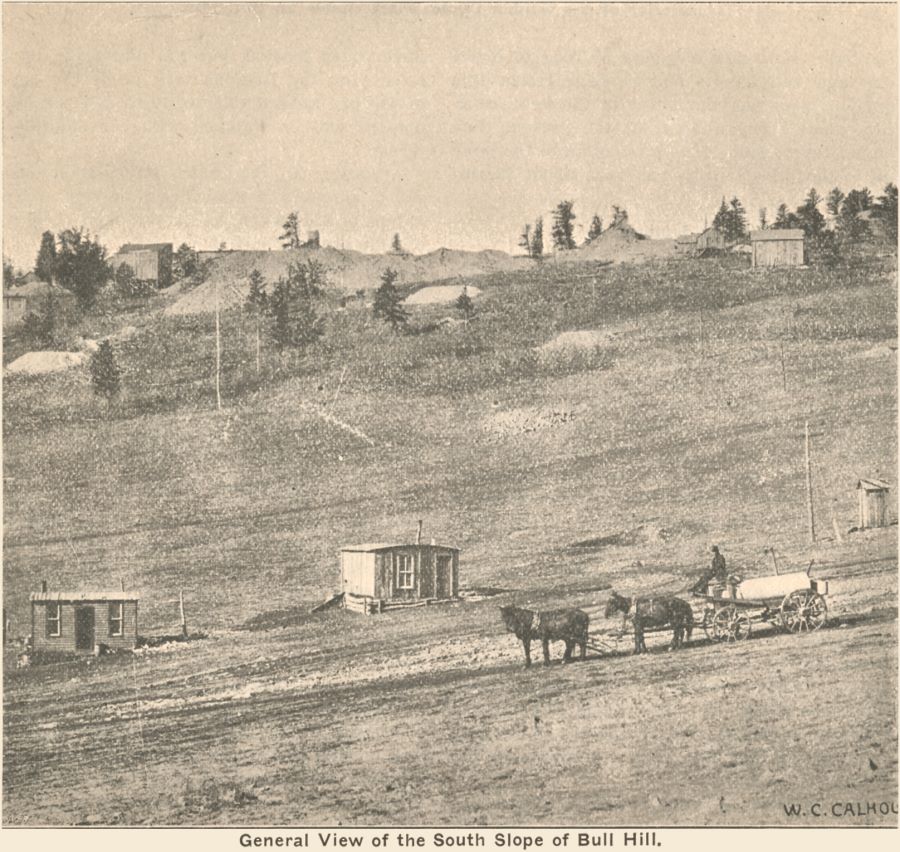 General View Bull hill.
General View Bull hill.
Since Colorado became a state the government lands that have passed into individual ownership amount to over 13,000,000 acres, 2,268,729 of which, used for agricultural purposes, are assessed for $25,000,000. Practically all are owned by men whose capital consisted of a team of horses and a wagon.